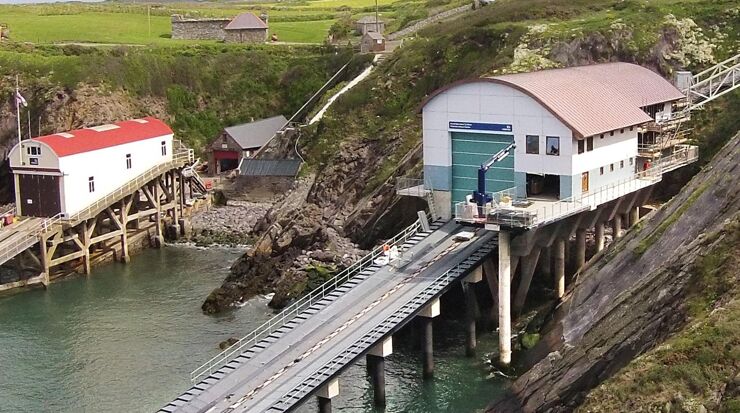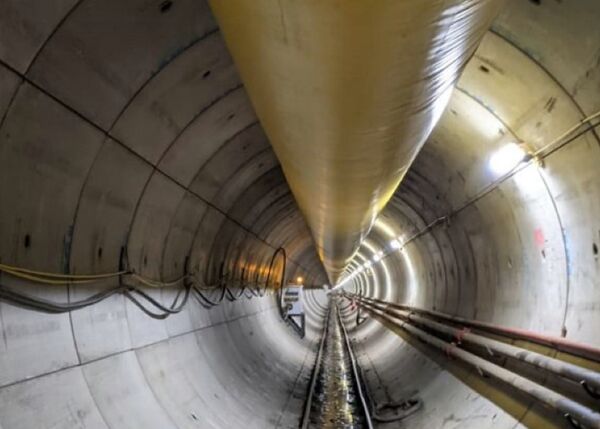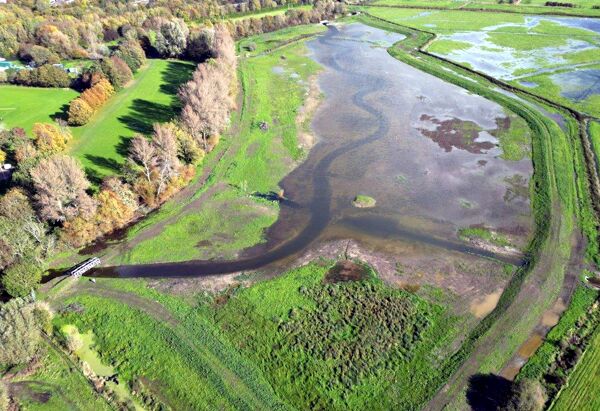
The new Royal National Lifeboat Institution (RNLI) lifeboat station at St Davids in Pembrokeshire, Wales completes a £75 million NEC-procured capital works programme to deliver new slipway stations for Tamar-class all-weather lifeboats.
The 25 knot, 32 t displacement Tamars are gradually replacing the older, smaller and slower Tyne class, resulting in the replacement or significant modification of 13 existing lifeboat stations. St Davids was the last and most challenging, being situated in a rocky cove at the base of a 60 m cliff. Access to the logistically remote location was further hindered by restricted narrow lanes regularly used by holiday makers.
Construction work has been carried out by contractor BAM Nuttall under an NEC-based framework. The St Davids scheme was let under an NEC3 Engineering and Construction Contract option A (priced contract with activity schedule) in June 2014 and was successfully completed in August 2016 for operation in September. The project was highly commended in the 2016 NEC Large Project of the Award.
Collaborative approach
According to RNLI’s chief engineer Christopher Refoy, ‘Building on knowledge, expertise and trust accumulated over the 10 year framework, the collaboration engendered by NEC continued to an even greater level at St Davids due to the extreme complexities of the project.
‘As on previous projects, early contractor involvement and a one-team approach generated specific engineering solutions – such as using a bespoke drill rig on a jack-up barge to install the slipway piles. In addition, to reduce the cost of the jack-up barge, BAM Nuttall previously advised us to take out a long-term charter, resulting in a £212,000 saving at St Davids and a cumulative saving over the framework of £810,000.’
However, once drilling started at St Davids, the project team got into difficulties due to unexpected characteristics of the rock strata into which they were attempting to drill piles. ‘This required a rapid redesign of the foundation system in the immediate area, grouping what was proposed as four individual pile caps into a single larger element,’ says Refoy.
‘Our building information model also picked up a clash between the boathouse piles and the cove cliffs. BAM Nuttall generated a series of different designs, each priced to keep within the budget. These included turning what were vertical columns into a radical ‘V’ column arrangement, which was finally agreed and accepted by all parties.’
He says other value-engineered and innovative solutions generated at St Davids included using a redundant shipping container to dam the rocky cove. ‘This reduced the impact of bad weather and created extra dry-space time, as equipment did not have to be lifted to the cliff top after each low tide. It also saved us over £100,000.’
Open and trusting relationship
Refoy says using NEC at St Davids helped to generate a very open and trusting relationship between all parties. ‘in particular the ECC option A activity schedule was produced using rates and prices that were checked against the open market. As a priced open book, RNLI could see exactly what had been priced and was checked against the budget by the employer’s cost consultants. Instances where the budget was overtopped stimulated intense efforts to value engineer solutions that met the remit of all parties.’
From a client perspective, Refoy says NEC’s open and transparent approach to resolution of issues as they arise is a major benefit. ‘There were numerous examples on the St Davids project, but a significant one was where we had to redesign the foundations at the last minute. From a contractual point of view, these late changes – with all the inherent opportunities for delay and potential conflict under a different form of contract – went so smoothly that we could all concentrate on resolving engineering matters rather than dealing with issues and aspects of cost.’
RNLI has been using NEC since 2005. ‘We recognise the significant benefits of the collaborative open approach embodied within the contracts,’ says Refoy. ‘On the very challenging St Davids project, NEC served us very well.’
Benefits of using NEC
- Helped to create an open, trusting and collaborative relationship between the parties, which was essential for delivering this technically challenging and complex project
- ECC option A activity schedule provided complete transparency on pricing, enabling the employer to check prices against budget and stimulating value engineering where needed
- NEC’s open and transparent approach to resolution of issues enabled the project team to focus on resolving engineering matters rather than spending unnecessary time dealing with costs



